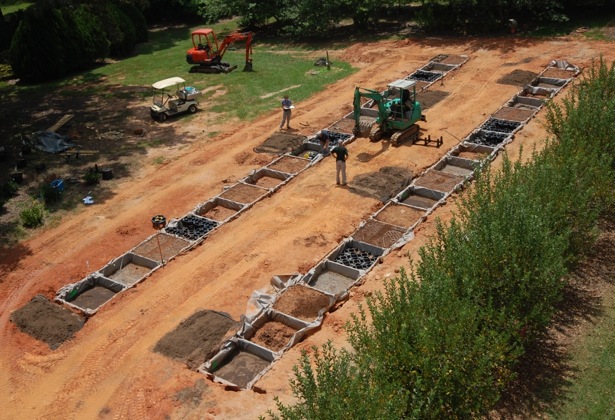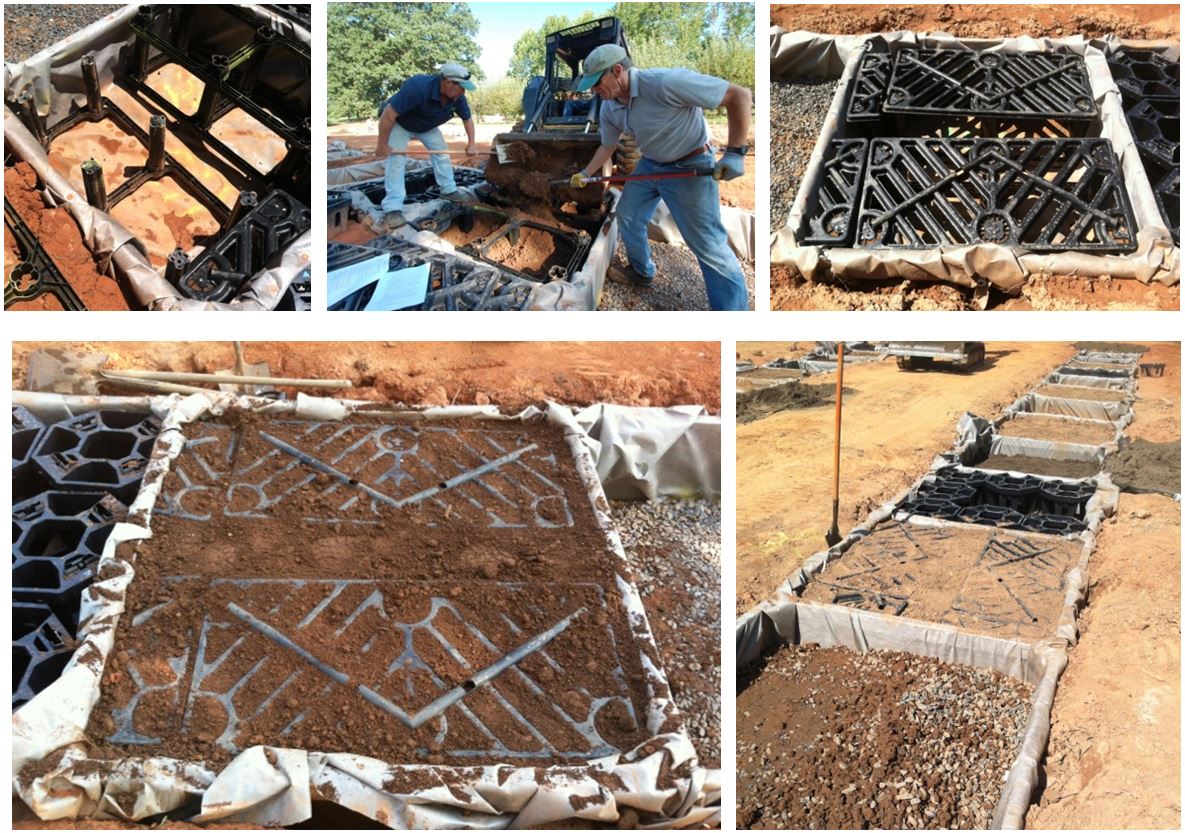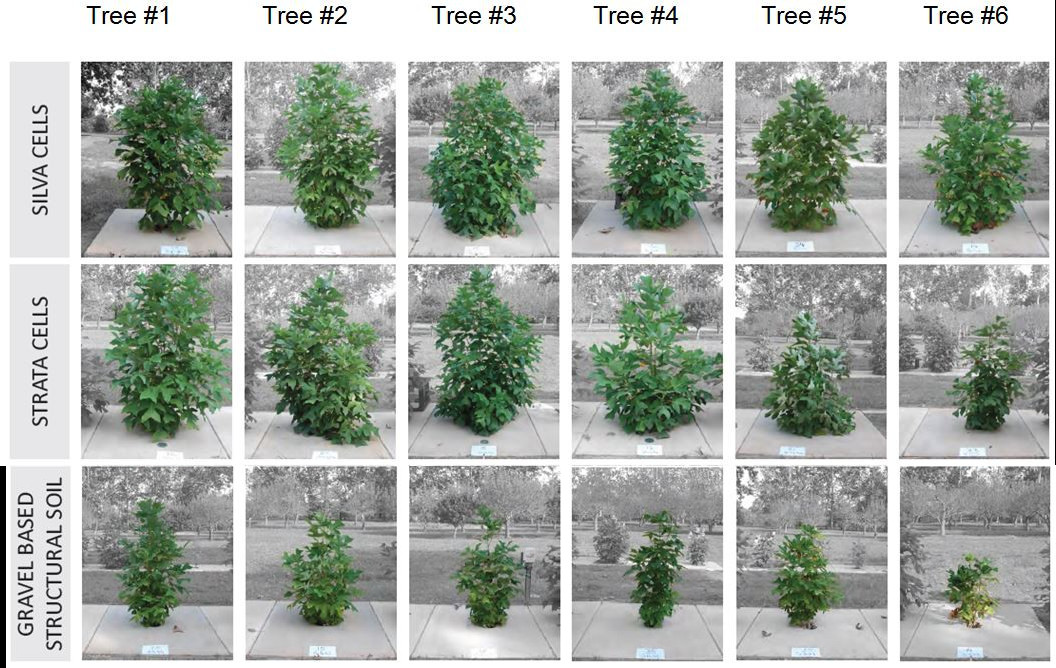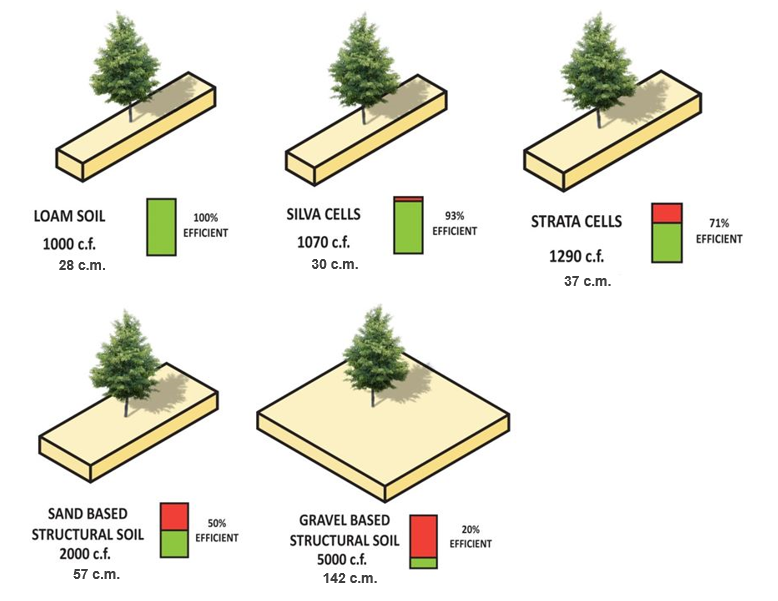Landscape architects have been designing options to improve rooting conditions for urban trees for decades. In that time, many ideas have been developed, with varying costs (for the clients) and outcomes (for the trees and the site at large). In summer 2015, Dr. Tom Smiley with Bartlett Tree Laboratories began a research study that is examining different approaches for creating rooting spaces under paving. Today, we want to share the preliminary results of the study.
Study Summary
The purpose of the study, which is being conducted by Dr. Tom Smiley and The Bartlett Tree Laboratory, is to test the effectiveness of different load-bearing soil options for tree growth. In July 2014, six different treatments were installed:
- Control – the soil mix was compacted to 80% Proctor.
- Compacted control – the soil mix was compacted to 95% Proctor to meet current standards for compaction under streets and structures typically found in most cities.
- Silva Cells – the soil mix was compacted to 80% Proctor within the Silva Cell structure.
- Strata Cells – the soil mix was installed but the soil density could not be tested due to the segmented nature of the product.
- Sand Based Structural Soil (SBSS) – the soil mix was very similar to Amsterdam soil. The basic formula was 4 parts medium to coarse (concrete) sand, 1 part topsoil loam and 1.5 parts mature compost. It was compacted to 94 – 96% Proctor.
- CU Structural Soil – a gravel based mix was defined and compacted according to specifications of Amereq, Inc. or Cornell University publications. The basic mix was 80% #5 stone, 20% soil mix and 0.003% hydrogel. The mix was compacted to 95% Proctor.
Tulip poplar trees (Liriodendron tulipifera) were planted in a random configuration in a 90 foot plot that simulated a city sidewalk. The trench was lined with Typar fabric to contain roots within the specified growing condition, and wood barriers were constructed at five foot intervals to hold the fabric and separate each of the plots. Soil, compaction and drainage was consistent in each replicate within each treatment. Irrigation and sunlight was the same for all treatments. Trees were clone cultivars of the same size at planting.
According to James Urban, FASLA, “Dr. Smiley’s work is a significant step in understanding the relationships of trees, soils, and pavements. Other areas of design that are equally important to successful trees that arborists and designers need to understand include, providing the right spacing between trees for a reasonable canopy growth; harvesting rain water into the root zone under the pavement; and assuring that trees are purchased with proper root systems. Good arborists can work with the trees natural functions and still make beautiful places that respect trees.”
Net Available Soil
As the study plots were assembled, actual (net) soil for each treatment was measured in order to assess the efficiency of the four solutions (Silva Cells, Strata Cells, Sand-Based Structural Soil, and Gravel-Based Structural Soil). In the case of the two suspended pavement treatments (Silva Cells and Strata Cells) the difference in net soil provided was, on average, 20.9%.
As indicated in the graphic below, the net soil delivered by each treatment varied substantially. The preliminary results, which show the trees in the most efficient treatment performing the best, suggest that soil volume calculations should always be based on soil efficiency (net available soil) rather than on area, volume, or amount of product alone. The following is a reasonable expectation of efficiency based on manufacturer claims and field observations.
We know that tree-friendly urban design is possible, yet we still struggle to get designers, owners, and builders to change their approach. We hope Dr. Smiley’s research will continue to push Urban Forestry in the direction of providing city trees with what they need to grow, mature, and provide meaningful environmental services.
An interim report by Dr. Smiley is expected this winter, and a full review of the study will be published when it’s completed.
References
Dr. Tom Smiley, Bartlett Tree Laboratory – personal communication
James Urban, FASLA, Urban Trees + Soils – personal communication
“A Better Way to Grow City Trees,” by Len Phillips.
Photos and study details courtesy of Bartlett Tree Expert Co.









The Dutch way.
Nice to see the tree results between the different available solution.
Also in the Netherlands – where we have a rich history and experience of planting solutions – we also distinguish the various solutions in the different groups. Good to see that our classification corresponds to the different solutions in Bartlett research. So I definitely want to follow this research.
Dutch classification:
Suspended pavement systems are subdivided in:
– Rootbunkers (NL Boombunkersysteem) like Silvacell
– Rootcrates (NL Boomkrattensysteem) like Stratacell
Structural soil are subdivided in:
– Rock based structural soils (NL Boomgranulaat) like CU soil
– Sand based structural soils (NL Bomenzand)
In experience we know that the result must be tested for al long term, because the difference between Rootbunker (Silvacell) and Rootcrates (stratacell) will be significant in future years. First experiment in the Netherlands with rootcrates was in 1997.
I find it unfortunate that for both sand- and rock based structural soils not the best/newest recipes are being used. I’m sure they will show a more consistent plant response.
How about the pictures of control trees (uncompacted and compacted soilmix)? Are these pictures also available?
best regards from Holland.
PS: I would not call the SBSS mix similar to our Amsterdam sand, it’s not by far.
This is a good study and very interesting. Additional information would also be helpful like the results from the control groups. Also it would be nice to see a study replicated with different species such as Bald Cypress and other street trees. Why is it that the trees seem to decline in health from left to right. Is that just a coincidence or did the #1 tree always preform the best and the # 6 tree always preformed the worst regardless of the soil treatment?
Thanks for posting the results from your study about the how soil conditions can influence the growth of trees. I know that having the right kind of topsoil delivered to your property or project can influence the vitality of the grass that will grow. It’s no surprise that soil can influence the health of trees. I’ll have to look for loam soil or Silva cells for my future trees that I plant.
Useful work_ will study further for application here in Ireland.
We’re in early stage of project pipelines for Urban Forestry in the Great Dublin Area, and with our Blue-Green Infrastructure Strategy in this local authority (dlr = Dún Laoghaire-Rathdown County Council), as a public landscape practice within Parks and Landscape Services unit. Will also be relating this to Portland City (Oregon) Council’s pioneering work in on-street, stormwater attenuation (‘Green Streets’ program), as we identify candidates street for Climate Change Adaption measures for our emerging Dlr and GDA CC Strategies.
Best wishes,
Aidan